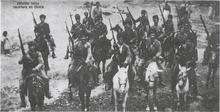Kuva-yi Milliye

Multi tool use
| Kuvâ-yi Milliye | |
|---|---|
 Kuvâ-yi Milliye infantrymen circa 1920 | |
| Active | 1918–1921 |
| Country | Ottoman Empire |
| Allegiance | |
| Type | Militia |
| Role | Turkish Independence |
| Size | 5,000 (1919) 15,000 (peak in 1920)[1] |
| Motto(s) | Ya istiklâl ya ölüm! (Independence or death!) |
| Colors | Red and White |
| Engagements | Turkish War of Independence |
| Commanders | |
| Notable commanders | Mustafa Kemal Pasha (Commander-in-chief) Yörük Ali Efe (Commander) Şahin Bey (Commander) Çerkes Ethem (Commander) Topal Osman (Commander) |
Kuva-yi Milliye (Ottoman Turkish: قواي ملّيه, Kuvâ-yi Milliye meaning either National Forces[2][3] or Nationalist Forces[4] in Ottoman Turkish) refers to the irregular Turkish militia forces[4] in the early period of the Turkish War of Independence. These irregular forces emerged after the occupation of the parts of Turkey by the Allied forces in accordance with the Armistice of Mudros. Later, Kuva-yi Milliye was integrated to the regular army (Kuva-yi Nizamiye)[4] of the Grand National Assembly. Some historians call this period (1918–20) of the Turkish War of Independence the "Kuva-yi Milliye phase".[5]
Contents
1 History
2 Dissolution of Kuva-yi Milliye
3 Rebels
4 See also
5 References
6 External links
History
In the Armistice of Mudros, Ottoman Empire was divided between the Allies, where the Greeks occupied the west, the British occupied the capital and southeast, and the Italians and the French occupied the south of the country. The Kuva-yi Milliye were the first armed groups to defend the Ottomans' rights in Anatolia and Rumelia. The Kuva-yi Milliye consisted of deserted Ottoman army officers and militias. The Kuva-yi Milliye became active when the Greeks landed at Symrna (İzmir).[citation needed] People who opposed the partitioning of Anatolia by the unratified Treaty of Sèvres joined the resistance. The Franco-Turkish War was almost exclusively conducted by Kuva-yi Milliye units on the Turkish side. In western Anatolia, the Kuva-yi Milliye fought against the Greek Army by hit-and-run tactics[6] until a regular army was set up. The resistance of the Kuva-yi Milliye slowed down the Greek advance in Anatolia.[7]

Kuva-yi Milliye millitias. The original image was dated 1919.
Dissolution of Kuva-yi Milliye
Although the Kuva-yi Milliye was regarded the first step of resistance in the liberation of Turkey, irregular warfare was abandoned later on. The militia lacked discipline and experience; they had no chance in larger open field battles against the Greeks. In September 1920, they had to face and halt the advance of a highly trained and well equipped Greek Army numbering more than 107,000 men with a force less than 15,000 on the western front. After the Grand National Assembly of Turkey was opened, the regular army was created by merging different Kuva-yi Milliye groups. Kuva-yi Milliye was ultimately dissolved towards the end of 1920. Although some units of the Kuva-yi Milliye still fought on the southern front until 1921. The First Battle of İnönü is the first war in which the standing army fought against the Greek forces.
Rebels
Some Kuva-yi Milliye groups, most notably Çerkes Ethem's Kuva-yi Seyyare refused to disband his forces and mutinied against the Ankara Government. Although Çerkes Ethem cooperated with the Greek Army, the Army of GNA defeated both the Greek Army and the Rebel Forces at the end of Turkish War of Independence.
See also
- Kuva-i Inzibatiye
References
^ Selek, Sabahattin (1987), Anadolu ihtilâli (in Turkish), 1, Kastaş AŞ Yayınları, p. 127.mw-parser-output cite.citationfont-style:inherit.mw-parser-output qquotes:"""""""'""'".mw-parser-output code.cs1-codecolor:inherit;background:inherit;border:inherit;padding:inherit.mw-parser-output .cs1-lock-free abackground:url("//upload.wikimedia.org/wikipedia/commons/thumb/6/65/Lock-green.svg/9px-Lock-green.svg.png")no-repeat;background-position:right .1em center.mw-parser-output .cs1-lock-limited a,.mw-parser-output .cs1-lock-registration abackground:url("//upload.wikimedia.org/wikipedia/commons/thumb/d/d6/Lock-gray-alt-2.svg/9px-Lock-gray-alt-2.svg.png")no-repeat;background-position:right .1em center.mw-parser-output .cs1-lock-subscription abackground:url("//upload.wikimedia.org/wikipedia/commons/thumb/a/aa/Lock-red-alt-2.svg/9px-Lock-red-alt-2.svg.png")no-repeat;background-position:right .1em center.mw-parser-output .cs1-subscription,.mw-parser-output .cs1-registrationcolor:#555.mw-parser-output .cs1-subscription span,.mw-parser-output .cs1-registration spanborder-bottom:1px dotted;cursor:help.mw-parser-output .cs1-hidden-errordisplay:none;font-size:100%.mw-parser-output .cs1-visible-errorfont-size:100%.mw-parser-output .cs1-subscription,.mw-parser-output .cs1-registration,.mw-parser-output .cs1-formatfont-size:95%.mw-parser-output .cs1-kern-left,.mw-parser-output .cs1-kern-wl-leftpadding-left:0.2em.mw-parser-output .cs1-kern-right,.mw-parser-output .cs1-kern-wl-rightpadding-right:0.2em
^ Akşin, Sina (2007), Turkey: From Empire to Revolutionary Republic: The Emergence of the Turkish Nation from 1789 to the Present, New York University Press, p. 126, ISBN 978-0-8147-0722-7
^ Shaw, Stanford J; Shaw, Ezel Kural (1977), History of the Ottoman Empire and Modern Turkey, 2, Cambridge University Press, p. 341, ISBN 978-0-521-29166-8
^ abc Smith, Elaine Diana (1959), Turkey: Origins of the Kemalist Movement and The Government of the Grand National Assembly, 1919–1923, The American university, p. 68
^ Kasalak, Kadir (November 1998), "Kuva-yı Milliye'nin Askeri Açıdan Etüdü", Atatürk Araştırma Merkezi Dergisi (in Turkish), Türkiye Cumhuriyeti'nin, XIV (42): 75. Yılı Özel Sayısı.
^ Belleten, 65 (244), Türk Tarih Kurumu, 2001, retrieved 2010-08-18
^ "Kuva‐i Milliye", Cum Huriyet, Etarih
External links
Kasalak, Kadir (November 1998), Kuva-yı Milliye'nin Askeri Açıdan Etüdü, XIV (42), Atatürk Araştirma Merkezi Dergisi, Türkiye Cumhuriyeti'nin 75. Yılı Özel Sayısı.
aJkLHQ8,zDtwZ3KKBW K wW,q6zs3awmm CtxOfe6POwsAmCdveKxuTfpeoY7a 2CdEz u1LNUB3